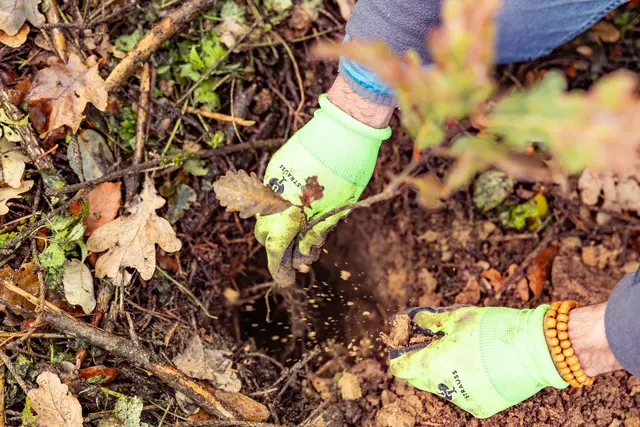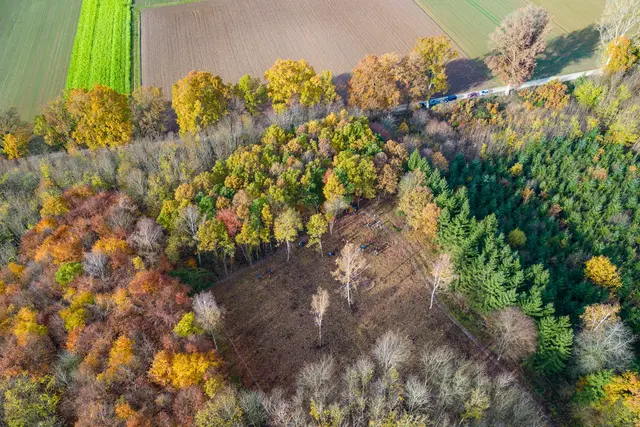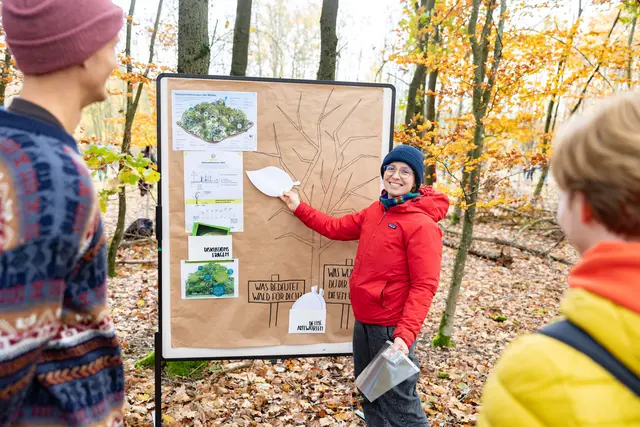The forest not only functions as a place of research, it is also anchored in the KU’s teaching practice and offers space for education for sustainable development. For the reforestation project, the Chair of Physical Geography/Landscape Ecology and Sustainable Ecosystem Development, headed by Prof. Dr. Susanne Jochner-Oette, is cooperating with the municipality of Nassenfels, the Ingolstadt-Pfaffenhofen an der Ilm Office for Food, Agriculture and Forestry and the Bavarian State Ministry of Food, Agriculture and Forestry. The KU's "Mensch in Bewegung” project aims to address questions of education for sustainable development (ESD) and integrate the area next to the Eichstätt Kapuzinergarten into a network of educational locations for ESD together with other areas.
A forest for research, teaching and transfer: KU reforestation project launched

The initiative for the project goes back to the Chancellor of the KU, Eckhard Ulmer. In an exchange with Professor Jochner-Oette, he considered how reforestation could be supported not only symbolically in distant places around the world, but also practically in the University’s immediate vicinity. After discussions with various authorities, the choice fell on an area in the municipality of Nassenfels, east of the village of Möckenlohe. A spruce stand in a 2,500 square meter piece of forest there had been destroyed by the bark beetle. "This was previously the bread tree of forestry", said Peter Birkholz (Head of Forestry at the AELF) at the start of the planting event. However, this type of tree is foreseeably susceptible to the consequences of climate change, so the strategy for the forests of the future is to spread the risk when choosing trees. The diversity of varieties that have now been planted in the area is correspondingly broad. In addition to oaks and hornbeams, checkertrees and European while elms can now also be found there. The latter are characterized, for example, by the fact that their roots reach particularly deep, giving them a better chance of reaching water even in drier periods.

Over 40 KU students and employees volunteered to plant around 1,500 seedlings. However, in order for these to grow into strong trees, it is not enough to simply dig a hole at random and cover the seedlings with soil. Forestry master Andreas Böhm therefore explained to the participants how to use the hollow spade properly. It is first used to scrape away the foliage and the raw humus, which must not get into the planting hole due to its acidic nature. A bale is dug out with two powerful stabs using the implement, the shield of which is shaped like a crescent moon. The rootstock must then be placed in the hole in such a way that the root is not compressed and grows vertically. The root collar must be deep enough in the soil so that the young plants do not dry out within a short time. The soil removed with the hollow spade is then crumbled back into the planting hole and gently trodden down. The forestry professionals on site had placed dipsticks on the area for orientation so that the rows of plants were evenly distributed. The municipality of Nassenfels organized catering for the hard-working volunteers and mayor Thomas Hollinger spoke of a win-win situation in order to promote the sustainable expansion of the forest.

Forests provide many ecosystem services that are important for humans and society – from carbon storage to temperature reduction. The forest, which is now growing from scratch in the area, offers Professor Susanne Jochner-Oette the opportunity to scientifically monitor its development from the outset from a variety of perspectives over the long term. To this end, various measuring devices are placed in the research forest to collect data series over the years. The monitoring questions that she will pursue together with her team and students range from soil moisture and temperature compared to open areas, pollen distribution and biodiversity to the amount of CO2 that is absorbed on the area. "I believe that the forest is a bioclimatic refuge with lower temperatures and better air quality. Forests will be visited more frequently in future as a result of climate change", says Professor Susanne Jochner-Oette. The students are deliberately involved in the continuous investigations, not only assisting with the planting, but also accompanying the series of measurements.

In general, not only long-term forestry and scientific aspects play a role in the project, as the head of the State Ministry of Food, Agriculture and Forestry, Hubert Bittlmayer, emphasized: "As well as the knowledge to select plants, we also need a sense of responsibility for forests and nature, which cannot be delegated to professionals alone. What we plant today, we have to look after for two generations!" That is why it is also important for everyone involved to raise awareness of the great importance of forests – for example, as an inspiration for other similar initiatives. The research forest will therefore not only be a place for teaching and research, but also for transfer to society. With this in mind, students – including many from the Master's degree program in Education for Sustainable Development – had developed various learning stations as part of a service-learning project, which not only provided information about soil and tree species or the bark beetle to accompany the planting campaign, but also encouraged discussion about what trees mean for each individual. They were supervised by "Mensch in Bewegung" employee Johanna Umbach, who is already coordinating the work in the Eichstätt Kapuzinergarten as a civic project for sustainability and education for sustainable development.
![[Translate to Englisch:] Thumb Forschungswald](/fileadmin/_processed_/c/b/csm_Thumb_Forschungswald_0d50c26566.webp)
Please note: By clicking on the image area, you give your consent for video content to be reloaded from YouTube, for YouTube/Google cookies to be stored on your IT system and for personal data such as your IP address to be passed on to Google. If you click on another video after having finished watching the video content, YouTube will open in a new tab of your browser and will collect more data from you. Further information is provided in our data protection notice and under Google Privacy .
![[Translate to Englisch:] Wald1](/fileadmin/_processed_/5/e/csm_Wald-11_4192dba32f.webp)